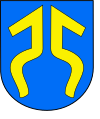 Alternate names: Pińczów [Pol], Pinchev, פינצ'וב [Yid], Pin'chuv, Пиньчув [Rus], Pinchov, Pintchov, Pintshev. 50°32' N, 20°32' E, 21 miles SSW of Kielce, 41 miles NE of Kraków. 1900 Jewish population: 5,194. Yizkor: Sefer zikaron le-kehilat Pintshev; in Pintshev togt shoyn nisht, (Tel Aviv, 1970). Jewish history. Pińczów is a town in Świętokrzyskie Voivodship, 40 km Sof Kielce and the capital of Pińczów powiat with a 2004 population is 11,943. The town was destroyed by Germans in September 1939 and almost all Jews were killed by them later. The Jewish cemetery was destroyed, but the Renaissance synagogue survived. Restoration has been in progress for twenty years. Jews have lived in Pińczów since the 16th century enjoying the privileges granted to them by Myszkowscy family. The synagogue located in the center of Jewish quarter is close to the extensive Jewish cemetery. The Mirów district south of the town became the center of the town's Jewish community. Both Jewish cemeteries were leveled during the 1960s. Several dozen surviving matzevot were used to build a lapidarium. [June 2009]
Alternate names: Pińczów [Pol], Pinchev, פינצ'וב [Yid], Pin'chuv, Пиньчув [Rus], Pinchov, Pintchov, Pintshev. 50°32' N, 20°32' E, 21 miles SSW of Kielce, 41 miles NE of Kraków. 1900 Jewish population: 5,194. Yizkor: Sefer zikaron le-kehilat Pintshev; in Pintshev togt shoyn nisht, (Tel Aviv, 1970). Jewish history. Pińczów is a town in Świętokrzyskie Voivodship, 40 km Sof Kielce and the capital of Pińczów powiat with a 2004 population is 11,943. The town was destroyed by Germans in September 1939 and almost all Jews were killed by them later. The Jewish cemetery was destroyed, but the Renaissance synagogue survived. Restoration has been in progress for twenty years. Jews have lived in Pińczów since the 16th century enjoying the privileges granted to them by Myszkowscy family. The synagogue located in the center of Jewish quarter is close to the extensive Jewish cemetery. The Mirów district south of the town became the center of the town's Jewish community. Both Jewish cemeteries were leveled during the 1960s. Several dozen surviving matzevot were used to build a lapidarium. [June 2009]
PINCZOW (I): US Commission No. POCE000299
The cemetery is located on Slabska Str, now Grodziskowe St. in the Kielce region at 50º 32 N 20º 32 E, 44 km from Kielce. Present population is 5,000-25,000, with no Jews.
- Town: Burmistor Miasta Pinczow, ul 3 Maja 10, 28-400 Pinczow, tel. 25-30.
- Local: Wojewodski Konserwator Zabytkow ul IX, Wekow Kielc 3, Kielce, tel. 45634.
The cemetery was established in the 15th century. 1921 Jewish population was 1324 (55.8%). Privilege granted by Zygmont in 1594. The unlandmarked cemetery was established in the 16th century or in 1680. The last known burial was 1942. The isolated urban flat land has no sign or marker. Reached by turning directly off a public road, access is open to all with no fence or gate. There are no stones OR Less than 25% of the surving stones are toppled or broken. 1-10 removed stones are in a museum "Pinczow State Museum." About 40 are incorporated into roads or structures in Pinczow. The 17th-20th century granite, limestone and sandstone finely smoothed and inscribed stones or flat stones with carved relief decoration have Hebrew and Yiddish inscriptions. There are no known mass graves. No structures. The municipality owns the property, now residential. Adjacent property is agricultural and residential. Private visitors rarely visit it. It was vandalized during WWI and WWII. There is no care. Incompatibile development is a very serious threat. Security and weather erosion are serious threats. Pollution, vegetation and vandalism are moderate threats. Property is used for agriculture and residential.
Adam Penkalla, deceased, completed this survey after a visit, using his own documentation. He may have more information.
PINCZOW (II): US Commission No. POCE000300
The cemetery is located on Cmentarna Str., now Nown str. See Pinczow (I) for town information. The unlandmarked Orthodox and Conservative cemetery was established in the 16th or 17th century with last burial in 1942. The urban flat land, separate but near other cemeteries, has no sign or marker. Reached by turning directly off a public road, access is open to all with no fence or gate.
PINCZOW (III): US Commission No. POCE000773
The unlandmarked suburban Orthodox and Conservative cemetery, between the road for Krakow, by the river Nida was established in 1592 with last known burial about 1700. The isolated suburban flat land has no sign or marker. Reached by turning directly off a public road, access is open to all with no fence or gate. No stones are visible. There are no known mass graves. No structures. The municipality owns the property used for agriculture as is adjacent property. It is rarely visited. It was vandalized during the war in 1700 trough 1735. No maintenance. Incompatible development is a serious threat. Security and weather erosion are moderate threats. Vegetation is a slight threat.
Adam Penkalla, deceased, completed survey, using his own documentation.
BOOK: Gruber, Ruth Ellen. Jewish Heritage Travel A Guide to East-Central Europe. New York: John Wiley & Sons, Inc., 1992. p. 59
UPDATE: http://www.polishjews.org/synag/pinczow.htm has synagogue sketch. [August 2005]
[UPDATE] Photos by Charles Burns [April 2016]
